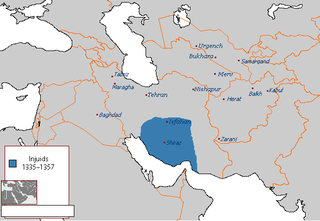
The House of Inju was a Shia dynasty of Mongol origin that came to rule over the Persian cities of Shiraz and Isfahan during the 14th century AD. Its members became de facto independent rulers following the breakup of the Ilkhanate until their defeat in 1357.
Haydar is an Arabic male given name, one of many names for "lion", each denoting some aspect of the animal, with "haydar" meaning "brave"; see Lions in Islam. In Islamic tradition, the name is primarily associated with the cousin of Muhammad, Ali, nicknamed "Haydar". It may also be used as a surname.

The Sulaymani branch of Tayyibi Isma'ilism is an Islamic community, of which around 70 thousand members reside in Yemen, while a few thousands of Sulaymani Bohras can be found in India. The Sulaymanis are headed by a da'i al-mutlaq from the Makrami family.

Togha Temür, also known as Taghaytimur, was a claimant to the throne of the Ilkhanate in the mid-14th century. Of the many individuals who attempted to become Ilkhan after the death of Abu Sa'id, Togha Temür was the only one who hailed from eastern Iran, and was the last major candidate who was of the house of Genghis Khan. His base of power was Gurgan and western Khurasan. His name "Togoy Tomor" means "Bowl/Pot Iron" in the Mongolian language.
Shams al-Din is an Arabic personal name or title.
Amir Vali was the ruler of Astarabad and parts of Mazandaran from 1356 until 1366, and again from c. 1374 until 1384. His relatively long reign was dominated by conflict with the Sarbadars and the Jalayirids, and ended only upon the arrival of Timur into eastern Persia.
Muhammad Aytimur was the leader of the Sarbadars of Sabzewar from 1343 until his death.
Kulū Isfandiyār was the leader of the Sarbadars of Sabzewar from 1346 until around 1347.
Shams al-Din was the leader of the Sarbadars of Sabzewar from 1347 until around 1348.
Karawi is an Arabic surname. Notable people with the surname include:
Hasan II, also known as Fakhr al-Dawla Hasan, was the last ruler of the Bavand dynasty from 1334 to 1349. He was the brother, and successor of Sharaf al-Muluk.
Eskandar II, was the ruler of the Paduspanid dynasty from 1333 to 1359. He was the son and successor of Taj al-Dawla Ziyar.





